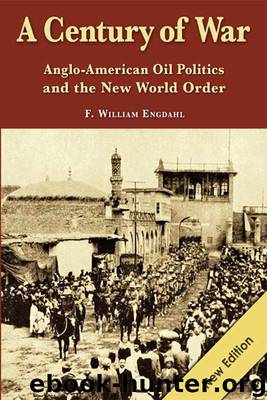A Century of War (Anglo-American Oil Politics and the New World Order) by F. William Engdahl

Author:F. William Engdahl
Language: eng
Format: epub
Publisher: mine.books
Published: 2011-10-19T22:00:00+00:00
Taking the bloom off the ‘nuclear rose’
One principal concern of the authors of the 400 percent oil price increase, was how to ensure their drastic action did not drive the world to accelerate an already strong trend towards construction of a far more efficient and ultimately less expensive alternative energy source–nuclear electricity generation.
Kissinger’s former dean at Harvard and his boss when Kissinger briefly served as a consultant to John Kennedy’s National Security Council was McGeorge Bundy. Bundy left the White House in 1966 in order to play a critical role in shaping the domestic policy of the United States as president of the largest private foundation, the Ford Foundation. By December 1971 Bundy had established a major new project for the foundation, the Energy Policy Project under direction of S. David Freeman, with an impressive $4 million checkbook, and a three year time limit. Precisely in the midst of debate during the 1974 oil shock, Bundy’s Ford study, titled, ‘A Time to Choose: America’s Energy Future,’ was released, in order to shape the public debate in the critical time of the oil crisis.
For the first time in American establishment circles the fraudulent thesis was proclaimed that, ‘Energy growth and economic growth can be uncoupled; they are not Siamese twins.’ Freeman’s study advocated bizarre and demonstrably inefficient ‘alternative’ energy sources such as windpower, solar reflectors and burning recycled waste. The Ford report made a strong attack on nuclear energy, arguing that the technologies involved could theoretically be used to make nuclear bombs. ‘The fuel itself or one of the byproducts, plutonium, can be used directly or processed into the material for nuclear bombs or explosive devices,’ they asserted.
The Ford study correctly noted that the principal competitor to the hegemony of petroleum in the future was nuclear energy, warning against the ‘very rapidity with which nuclear power is spreading in all parts of the world and by development of new nuclear technologies, most notably the fast breeder reactors and the centrifuge method of enriching uranium.’ The framework of the U.S. financial establishment’s anti-nuclear ‘green’ assault had been defined by Bundy’s project.9
By the early 1970’s nuclear technology had clearly established itself as the preferred future choice for efficient electric generation, vastly more efficient (and environmentally friendly) than either oil or coal. At the time of the oil shock, the European Community was already well into a major nuclear development program. Plans of member governments as of 1975 called for completion of between 160 and 200 new nuclear plants across Continental Europe by 1985.
In 1975, the Schmidt government in Germany, reacting rationally to the implications of the 1974 oil shock, passed a program which called for an added 42 GigaWatts of German nuclear plant capacity, for a total of approximately 45 percent of German total electricity demand by 1985, a program exceeded in the EC only by France’s, which projected 45 GigaWatts new nuclear capacity by 1985. Italy’s Industry Minister Carlo Donat Cattin in the fall of 1975, instructed Italy’s nuclear companies, ENEL and
Download
This site does not store any files on its server. We only index and link to content provided by other sites. Please contact the content providers to delete copyright contents if any and email us, we'll remove relevant links or contents immediately.
Life 3.0: Being Human in the Age of Artificial Intelligence by Tegmark Max(5184)
The Sports Rules Book by Human Kinetics(4078)
The Age of Surveillance Capitalism by Shoshana Zuboff(3985)
ACT Math For Dummies by Zegarelli Mark(3852)
Blood, Sweat, and Pixels by Jason Schreier(3492)
Unlabel: Selling You Without Selling Out by Marc Ecko(3470)
Hidden Persuasion: 33 psychological influence techniques in advertising by Marc Andrews & Matthijs van Leeuwen & Rick van Baaren(3292)
Urban Outlaw by Magnus Walker(3242)
The Pixar Touch by David A. Price(3208)
Bad Pharma by Ben Goldacre(3095)
Project Animal Farm: An Accidental Journey into the Secret World of Farming and the Truth About Our Food by Sonia Faruqi(3018)
Brotopia by Emily Chang(2897)
Kitchen confidential by Anthony Bourdain(2824)
Slugfest by Reed Tucker(2803)
The Content Trap by Bharat Anand(2778)
The Airbnb Story by Leigh Gallagher(2700)
Coffee for One by KJ Fallon(2422)
Smuggler's Cove: Exotic Cocktails, Rum, and the Cult of Tiki by Martin Cate & Rebecca Cate(2338)
Beer is proof God loves us by Charles W. Bamforth(2249)
